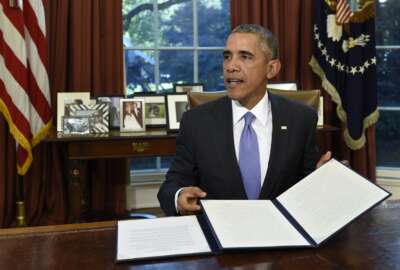
Military officials ignore first fiscal quarter due to CRs
The military service chiefs say continuing resolutions are keeping them from planning ahead and costing them money.
Top military officials admitted to Congress today that the trend of long-term continuing resolutions has completely shifted the way they plan their yearly budgets.
The military services basically write off any major planning for the first quarter of the fiscal year due to Congress’ inability to pass appropriations bills on time, Chief of Naval Operations Adm. John Richardson told the Senate Armed Services Committee during a Sept. 15 hearing.
Richardson’s revelation comes as the military is bracing for the possibility of another long term continuing resolution for 2017. It is almost a certainty that Congress will pass at least a short term resolution to keep the government running when the 2016 fiscal year ends at the end of September.
For all but one of the past eight years, the military services have dealt with the uncertainty of a long-term continuing resolution, Richardson said.
“Behaviors have modified to adapt to the reality of the last eight years. Big programs that require authorities for new starts, those are all prohibited in a continuing resolution environment and so rather than put those programs in the first quarter and put them all at risk, we just live in a three-quarter year and that first quarter is a light touch on just trying to keep things going,” Richardson said.
Other military service chiefs testified that the inability to plan ahead and a truncated fiscal year lead to the services wasting money on contacts.
Army Chief of Staff Gen. Mark Milley told lawmakers that multiyear contracts and relationships with industry partners suffer.
“It’s built in inefficiency. It’s built in cost overruns. It’s not a good situation,” Milley said.
Air Force Chief of Staff Gen. David Goldfein echoed Milley’s statements.
If a continuing resolution goes longer than three months into fiscal 2017, the Air Force would lose out on about $1.3 billion. The KC-46 would go from 15 to 12 aircraft, 60 acquisition programs and 50 military construction would be affected due to the resolution.
The Air Force was also able to predict how much money it would spend on munitions in 2017 and cut a deal with industry. A long-term continuing resolution would jeopardize that deal and leave the Air Force buying at the 2016 rates.
“We will be procuring preferred munitions at a lower rate, which not only affects all of us that are engaged in the campaign, but it also affects our coalition partners who are relying on us for preferred munitions,” Goldfein said.
While the service chiefs warned about the possibility of a continuing resolution, the thought of the return of sequestration seemed to strike them with even more fear.
All four military chiefs told the committee the return of sequestration would be a huge risk to their services.
Congress is still working on its defense appropriations bill. The Senate has not passed its version and, if it is passed, it seems unlikely the Senate and House can reconcile their differences on how to fund the military.
The House defense appropriations bill uses a similar tactic as the House defense authorization bill to fund extra programs the Defense Department did not request.
The House bill takes money out of the overseas contingency operations (OCO) budget and adds it to the base budget to fund an increase in the military pay raise and an bump in military end strength.
The Obama administration has already said it is displeased by the tactic, stating that taking money from OCO leaves the fund to dry up in April 2017. Congress would then have to pass another budgetary supplemental to pay for the wars overseas.
The White House says that creates a fiscal cliff for war funds.
Copyright © 2025 Federal News Network. All rights reserved. This website is not intended for users located within the European Economic Area.
Scott Maucione is a defense reporter for Federal News Network and reports on human capital, workforce and the Defense Department at-large.
Follow @smaucioneWFED




